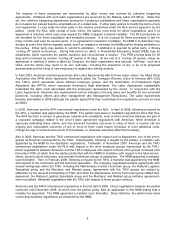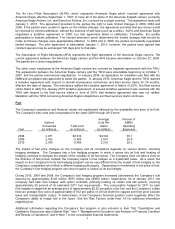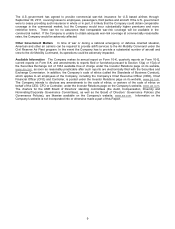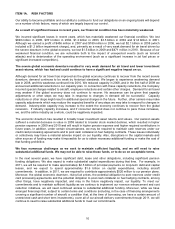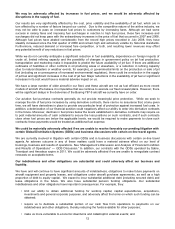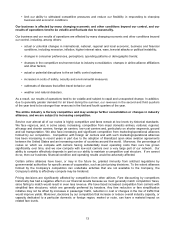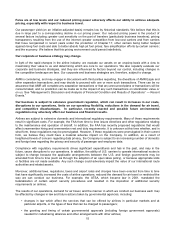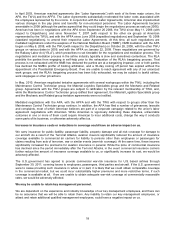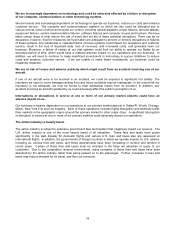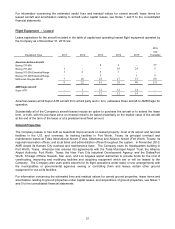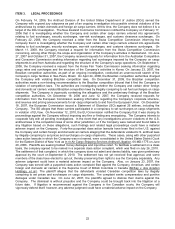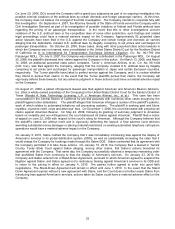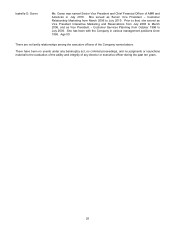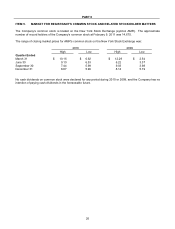American Airlines 2010 Annual Report Download - page 19
Download and view the complete annual report
Please find page 19 of the 2010 American Airlines annual report below. You can navigate through the pages in the report by either clicking on the pages listed below, or by using the keyword search tool below to find specific information within the annual report.
16
•
restrictions on competitive practices (for example court orders, or agency regulations or orders, that would
curtail an airline’s ability to respond to a competitor);
•
the adoption of new passenger security standards or regulations that impact customer service standards
(for example, “passenger bill of rights”);
•
restrictions on airport operations, such as restrictions on the use of takeoff and landing slots at airports or
the auction or reallocation of slot rights currently or previously held by us; or
•
the adoption of more restrictive locally imposed noise restrictions.
In addition, the U.S. air traffic control (ATC) system, which is operated by the FAA, is not successfully managing
the growing demand for U.S. air travel. U.S. airlines carry about 750 million passengers a year and are forecast to
accommodate a billion passengers annually by 2021. Air traffic controllers rely on outdated technologies that
routinely overwhelm the system and compel airlines to fly inefficient, indirect routes. We support a common sense
approach to ATC modernization that would allocate costs to all ATC system users in proportion to the services
they consume. Reauthorization of legislation that funds the FAA, which includes proposals regarding upgrades to
the ATC system, is under consideration in Congress. It is uncertain whether such legislation will become law. In
the meantime, FAA funding continues under temporary periodic extensions.
Many aspects of our operations are subject to increasingly stringent environmental regulations. Concerns about
climate change and greenhouse gas emissions, in particular, may result in the imposition of additional legislation
or regulation. The EU has adopted a directive under which each EU member state is required to extend the
existing EU emissions trading scheme (ETS) to aviation. This will require the Company to annually submit
emission allowances in order to operate flights to and from EU member states in January 2012 and thereafter,
including flights between the U.S. and EU member states. In December 2009, the ATA, joined by American,
Continental and United, filed a legal action in the United Kingdom challenging the implementation of the EU ETS
as applied to aviation. We believe that non-EU governments are also likely to consider formal challenges to the
EU ETS as applied to aviation. It is not clear whether the EU ETS will withstand such challenges. However,
unless interim relief is granted, we will be required to continue to comply with the EU ETS during the pendency of
the legal challenges. Although the cost of compliance with the EU ETS is difficult to predict given the uncertainty
of a number of variables, such as the number and price of emission allowances we may be required to purchase,
such costs could be significant.
Other legislative or regulatory actions addressing climate change and emissions from aviation that may be taken
in the future by the U.S., state or foreign governments or through international treaties may adversely affect our
business and financial results. The United Nations’ International Civil Aviation Organization (“ICAO”), for
example, recently adopted a resolution identifying certain fuel efficiency goals and emission trading system
principles for international aviation, which may provide a basis for such future legislative or regulatory action.
Climate change legislation was previously introduced in the U.S. Congress; such legislation could be re-
introduced in the future by the U.S. Congress and state legislatures, and could contain provisions affecting the
aviation industry. In addition, the EPA could seek to regulate greenhouse gas emissions from aircraft. It is
currently unknown how climate change legislation or regulation, if enacted, would specifically apply to the aviation
industry. However, the impact on us of any climate change legislation or regulation is likely to be adverse and
related costs of compliance could be significant. Such legislation or regulation could result in, among other
things, increased fuel costs, carbon taxes or fees, the imposition of requirements to purchase emission offsets or
credits, increased aircraft and equipment costs, and restrictions on the growth of airline operations. We continue
to evaluate ongoing climate change developments at the international, federal and state levels and assess the
potential associated impacts on our business and operations.
We could be adversely affected by conflicts overseas or terrorist attacks.
Actual or threatened U.S. military involvement in overseas operations has, on occasion, had an adverse impact
on our business, financial position (including access to capital markets) and results of operations, and on the
airline industry in general. The continuing conflicts in Iraq and Afghanistan, or other conflicts or events in the
Middle East or elsewhere, may result in similar adverse impacts.
The Terrorist Attacks had a material adverse impact on us. The occurrence of another terrorist attack (whether
domestic or international and whether against us or another entity) could again have a material adverse impact on
us.


